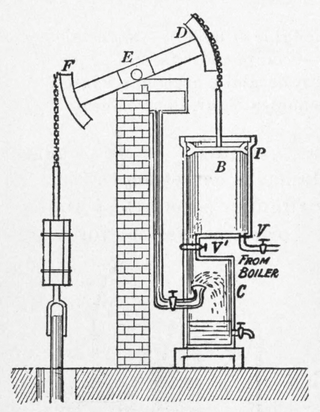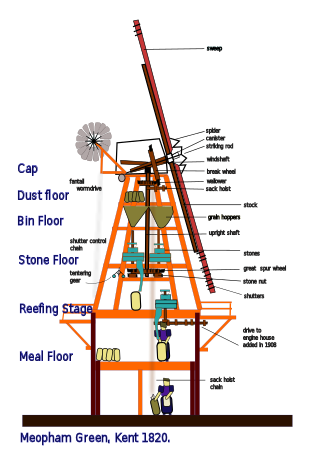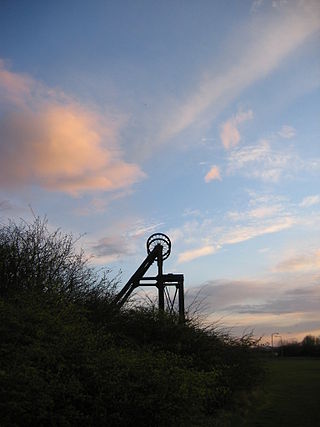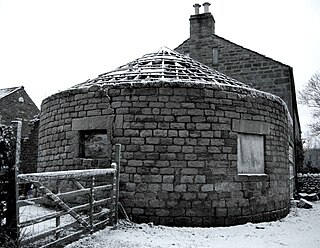Horse mill at Beamish Museum
This horse mill has not been used since about 1830 when it was superseded by portable engines. It was rescued from Berwick Hills Low Farm in Northumberland by the museum, repaired and set up in their own gin gang at Home Farm as a non-functioning exhibit. The top of the mill's main vertical axle and the end of the main drive shaft are pivoted at the centre of their own separate tie beam which is below and parallel with the main roof tie beam, and set in the gin gang's side walls at either end. The mill's tie beam has to be stabilised with two massive oak beams which run, either side of the drive shaft, from tie beam to threshing barn wall. A large and basic engine like this can create great stresses from the torque engendered. [4]
Main axle of mill. Roof
truss above is separate; mill's own
tie beam visible between.
Housing for top pivot of main axle, bolted to its own tie beam, separate from roof truss (visible above)
Drive shaft gear resting on main horizontal gear wheel which is attached to top of main vertical axle of mill
The two pivots: end of drive shaft (centre) and top of main axle (behind)
Mill construction
This four-horse mill is based on a central, vertical, heavy, 10 feet (3.0 m) high, oak axle, with its base pivoting on an iron framework set in the middle of the gin gang floor. Its top end pivots under the mill's own tie beam (if it didn't, it would fall over) but the tie beam cannot rest on the pivot, or the mill would not turn. The main axle supports around its top end the main, 6 feet (1.8 m)-diameter, horizontal gear wheel, with the teeth on the top surface. The main drive shaft, a massive oak pole, is girthed at one end by a secondary gear wheel which lies on the main gear wheel, thus turning the main drive shaft on its long axis. The main drive shaft runs from the main gear wheel through a hole in the threshing barn wall and in the barn it powers the threshing machine and other machines via further cogwheels and belts. Such a machine would create great torque stresses, and if it were ever to work again it would require re-engineering to ensure smooth and safe running, and beams which are seasoned and not cracked. [4]
Main horizontal
gear wheel at top of main axle, with
drive shaft gear wheel on it. Drive shaft transfers power through
threshing barn wall.
Horse
shaft fixed to one of four long beams, all braced to each other with
stretchers, and each fixed to the side of the top of the main axle.
One of four long beams, each with horse shaft hanging from it.
A four-horse mill requires a large working space
Horse power
This is a powerful horse mill for four horses; probably English ponies, as modern heavy horses were not yet fully bred in the 1830s. Each of the four heavy oak beams connecting the central axle to the four horse shafts runs from beside the axle to the under-surface of the main gear wheel, and crosses the other three in a grid pattern between the axle and gear wheel, thus supporting the gear wheel and creating a rigid structure at the same time. They project for many feet beyond the main gear wheel, and require wooden stretchers to stabilise them. From the ends of these beams hang the horse shafts. The bottom ends of these shafts are quite low, which may indicate the use of ponies rather than early heavy horses. [4]

An axle or axletree is a central shaft for a rotating wheel or gear. On wheeled vehicles, the axle may be fixed to the wheels, rotating with them, or fixed to the vehicle, with the wheels rotating around the axle. In the former case, bearings or bushings are provided at the mounting points where the axle is supported. In the latter case, a bearing or bushing sits inside a central hole in the wheel to allow the wheel or gear to rotate around the axle. Sometimes, especially on bicycles, the latter type of axle is referred to as a spindle.

The atmospheric engine was invented by Thomas Newcomen in 1712, and is often referred to as the Newcomen fire engine or simply as a Newcomen engine. The engine was operated by condensing steam drawn into the cylinder, thereby creating a partial vacuum which allowed the atmospheric pressure to push the piston into the cylinder. It was historically significant as the first practical device to harness steam to produce mechanical work. Newcomen engines were used throughout Britain and Europe, principally to pump water out of mines. Hundreds were constructed throughout the 18th century.

The Watt steam engine design became synonymous with steam engines, and it was many years before significantly new designs began to replace the basic Watt design.

Puffing Billy is the world's oldest surviving steam locomotive, constructed in 1813–1814 by colliery viewer William Hedley, enginewright Jonathan Forster and blacksmith Timothy Hackworth for Christopher Blackett, the owner of Wylam Colliery near Newcastle upon Tyne, in the United Kingdom. It was employed to haul coal chaldron wagons from the mine at Wylam to the docks at Lemington in Northumberland.

A drive shaft, driveshaft, driving shaft, tailshaft, propeller shaft, or Cardan shaft is a component for transmitting mechanical power and torque and rotation, usually used to connect other components of a drivetrain that cannot be connected directly because of distance or the need to allow for relative movement between them.

A beam engine is a type of steam engine where a pivoted overhead beam is used to apply the force from a vertical piston to a vertical connecting rod. This configuration, with the engine directly driving a pump, was first used by Thomas Newcomen around 1705 to remove water from mines in Cornwall. The efficiency of the engines was improved by engineers including James Watt, who added a separate condenser; Jonathan Hornblower and Arthur Woolf, who compounded the cylinders; and William McNaught, who devised a method of compounding an existing engine. Beam engines were first used to pump water out of mines or into canals but could be used to pump water to supplement the flow for a waterwheel powering a mill.
A horse engine is a machine for using draft horses to power other machinery. It is a type of animal engine that was very common before internal combustion engines and electrification. A common design for the horse engine was a large treadmill on which one or more horses walked. The surface of the treadmill was made of wooden slats linked like a chain. Rotary motion from the treadmill was first passed to a planetary gear system, and then to a shaft or pulley that could be coupled to another machine. Such powers were called tread powers, railway powers, or endless-chain powers. Another common design was the horse wheel or sweep power, in which one or several horses walked in a circle, turning a shaft at the center. Mills driven by horse powers were called horse mills. Horse engines were often portable so that they could be attached to whichever implement they were needed for at the time. Others were built into horse-engine houses.

Caphouse Colliery, originally known as Overton Colliery, was a coal mine in Overton, near Wakefield, West Yorkshire, England. It was situated on the Denby Grange estate owned by the Lister Kaye family, and was worked from the 18th century until 1985. It reopened as the Yorkshire Mining Museum in 1988, and is now the National Coal Mining Museum for England.

A portable engine is an engine, either a steam engine or an internal combustion engine, that sits in one place while operating, but is portable and thus can be easily moved from one work site to another. Mounted on wheels or skids, it is either towed to the work site or moves there via self-propulsion.

This glossary of mill machinery covers the major pieces of machinery to be found in windmills, watermills and horse mills. It does not cover machinery found in modern factories.

Prestongrange Museum is an industrial heritage museum at Prestongrange between Musselburgh and Prestonpans on the B1348 on the East Lothian coast, Scotland. Founded as the original site of the National Mining Museum, its operation reverted to East Lothian Council Museum Service in 1992.

A whim, also called a whim gin or a horse capstan, is a device similar to a windlass which is used in mining for hauling materials to the surface. It comprises a capstan or a wide drum with a vertical axle. A rope is wound around the drum, with both ends traversing several pulleys and hanging down the mine shaft. As the drum is turned around, one end of the rope is lowered, carrying an empty bucket, while the other one is raised, carrying a full load.

A gin gang, wheelhouse, roundhouse or horse-engine house, is a structure built to enclose a horse engine, usually circular but sometimes square or octagonal, attached to a threshing barn. Most were built in England in the late 18th and early 19th centuries. The threshing barn held a small threshing machine which was connected to the gin gang via wooden gears, drive shafts and drive belt, and was powered by a horse which walked round and round inside the gin gang.

The Ingleton Coalfield is in North Yorkshire, close to its border with Lancashire in north-west England. Isolated from other coal-producing areas, it is one of the smallest coalfields in Great Britain.
Gin Pit was a coal mine operating on the Lancashire Coalfield from the 1840s in Tyldesley, Greater Manchester then in the historic county of Lancashire, England. It exploited the Middle Coal Measures of the Manchester Coalfield and was situated to the south of the Tyldesley Loopline.

The South African Railways Class GM 4-8-2+2-8-4 of 1938 was an articulated steam locomotive.

Six-column beam engines are a type of beam engine, where the beam's central pivot is supported on a cast-iron frame or 'bedstead', supported on six iron columns.
Resolution was an early beam engine, installed between 1781 and 1782 at Coalbrookdale as a water-returning engine to power the blast furnaces and ironworks there. It was one of the last water-returning engines to be constructed, before the rotative beam engine made this type of engine obsolete.

The Wanlockhead beam engine is located close to the Wanlock Water below Church Street on the B797 in the village of Wanlockhead, Parish of Sanquhar, Dumfries and Galloway, Scotland. The site is in the Lowther Hills above the Mennock Pass, a mile south of Leadhills in the Southern Uplands. This is the only remaining original water powered beam engine in the United Kingdom and still stands at its original location. It ceased working circa 1910 after installation circa 1870.



































